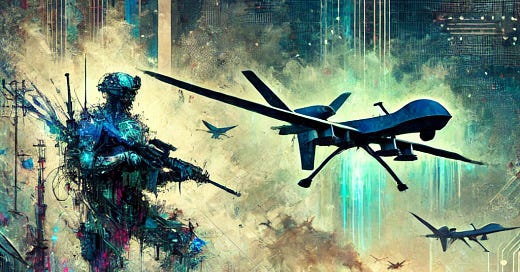Voice-over provided by Amazon Polly
Also, check out Eleven Labs, which we use for all our fiction.
YOUTUBE
Preface:
This article is a product of ARTIE (Automated Research and Thematic Information Engine), a fully AI-driven system designed to generate in-depth opinion pieces with minimal human oversight. Like all of ARTIE's outputs, this article is fundamentally unedited and presented as-is, showcasing ARTIE's capability to analyze complex issues based on predefined prompts and autonomous research. While the content is rich in factual information and diverse perspectives, it is important to note that it has not undergone editorial refinement or human fact-checking. This approach allows for direct insight into how AI processes and synthesizes knowledge but also carries the inherent limitations of machine-generated content.
Summary of the Prompt(s) Used:
This article was created based on the following prompt:
Let's specifically write an article on AI in Warfare and Autonomous Weapons: Analyze the growing concern over AI's role in military applications. Are we heading toward a future where machines decide life and death? Examine the arguments for and against autonomous weapons and the global push for regulations. Browse as needed.
Through this prompt, ARTIE developed an article that explores the intricate balance between AI's potential benefits in military applications and the profound ethical, legal, and humanitarian risks it poses.
Conrad Hannon
The Future of Warfare: Are We Ready for Autonomous Weapons?
Artificial Intelligence (AI) has made significant strides in various sectors, transforming industries and daily life in unprecedented ways. One of the more controversial and alarming applications of AI, however, lies in its potential use in warfare—particularly in autonomous weapons systems (AWS). The question of whether we are heading toward a future where machines decide matters of life and death is not just theoretical anymore; it's an urgent issue facing militaries, policymakers, and ethicists alike.
This article explores the growing concerns over AI's role in military applications, especially AWS, and examines the arguments for and against these systems, alongside the global push for regulation.
The Promise of Autonomous Weapons
Advocates of autonomous weapons argue that they offer several distinct advantages in modern warfare. One of the primary benefits is efficiency. AI systems, particularly those equipped with machine learning algorithms, can process vast amounts of data more quickly and accurately than humans. This can translate into faster decision-making, better targeting precision, and more efficient resource allocation during military operations.
For instance, AI-powered drones or missile defense systems can detect and neutralize threats in real-time, making split-second decisions that could potentially save lives. These systems can operate in environments that are either too dangerous or too difficult for human soldiers, thus reducing casualties on the battlefield(Just Security)(War on the Rocks).
Additionally, autonomous weapons can offer a more scalable solution to modern warfare. AI systems can be deployed across vast terrains, from the air to underwater, without needing the physical and psychological stamina required of human soldiers. With AI, militaries can engage in sustained operations while maintaining a smaller, more efficient force. This, in turn, can lower long-term costs(Home).
However, while these potential benefits are significant, they do not come without considerable risks.
Ethical and Humanitarian Concerns
The ethical challenges posed by autonomous weapons are profound, particularly concerning the dehumanization of warfare. At the core of the debate is the issue of removing human judgment from life-and-death decisions. In traditional warfare, human operators make real-time judgments about when and how to use force, often weighing the potential for collateral damage and the ethical implications of their actions. Autonomous weapons, however, may not have the capacity for such nuanced decision-making.
The International Committee of the Red Cross (ICRC) has raised concerns about the inability of AWS to fully comply with International Humanitarian Law (IHL), which mandates the distinction between combatants and civilians(ICRC)(War on the Rocks).
For example, AI systems may lack the situational awareness and ethical reasoning necessary to distinguish between a legitimate military target and a civilian bystander. Furthermore, machine learning systems—often described as "black boxes"—operate with a level of opacity that makes it difficult for operators to fully understand why a system made a particular decision.
This opacity complicates accountability. In cases where AWS are responsible for wrongful deaths, it becomes unclear who should be held accountable: the machine's operators, the engineers who programmed it, or the military commanders who authorized its use? These questions are especially concerning in situations where autonomous weapons might make errors or act unpredictably(ICRC)(War on the Rocks).
The Legal Landscape: Is IHL Enough?
Currently, many states argue that existing legal frameworks, particularly International Humanitarian Law (IHL), are sufficient to govern the use of AWS. Countries like the United States, Russia, and the United Kingdom have stressed that IHL provides adequate protection by requiring compliance with principles such as distinction, proportionality, and necessity(War on the Rocks).
These principles ensure that military operations are conducted in a manner that minimizes harm to civilians and limits unnecessary suffering during conflict.
However, critics argue that IHL was designed for human-operated weapons systems and does not adequately account for the unique risks posed by autonomous systems. For instance, under IHL, combatants must be able to make context-dependent legal judgments, such as determining whether a particular strike would result in excessive civilian harm relative to the military advantage gained. Autonomous weapons, however, lack the moral agency and ethical reasoning necessary to make such judgments(War on the Rocks).
Moreover, IHL emphasizes accountability and the possibility of legal redress when violations occur. But with AWS, assigning responsibility becomes murky. If an autonomous weapon mistakenly targets civilians, who is held accountable? The machine's human operators may not have had full control over the system's actions, and the developers may claim they cannot be responsible for the system's real-time decisions in a dynamic combat environment(ICRC).
The Risk of Escalation and Unintended Consequences
Autonomous weapons also carry the risk of unintended escalation in conflict. AI systems, particularly those designed to react in milliseconds, could potentially accelerate the pace of conflict beyond human control. This risk is especially acute in high-stakes situations, such as nuclear standoffs, where split-second decisions could have catastrophic consequences.
A 2021 UN report emphasized that as AI systems become more integrated into military operations, the risk of accidents or miscalculations increases(War on the Rocks)(Home).
AWS may misinterpret ambiguous data or fail to account for rapidly changing circumstances, leading to unintended attacks on civilians or friendly forces. In such cases, the rapid escalation of violence could spiral out of control before human intervention is possible.
This risk of escalation is compounded by the fact that AWS may be deployed in environments where communication between human operators and the system is compromised, such as in electronic warfare scenarios or areas with limited connectivity. In these cases, autonomous systems may be forced to act without human oversight, increasing the potential for mistakes(ICRC)(Home).
Arguments Against Autonomous Weapons
Several advocacy groups, along with international organizations such as the ICRC, have called for a preemptive ban on lethal autonomous weapons. Their central argument is that ceding life-and-death decisions to machines crosses an unacceptable ethical line. Even if AWS were to function perfectly within the bounds of IHL, the delegation of such decisions to AI undermines the moral agency that has traditionally governed the use of force in conflict(ICRC).
Critics also point to the risk of biased algorithms in AWS. AI systems, particularly those based on machine learning, are only as good as the data they are trained on. If the training data is biased—whether in terms of race, geography, or behavior—AWS could make discriminatory decisions, disproportionately targeting certain groups(ICRC).
This risk is especially pronounced in regions where militaries rely on biased datasets to identify potential threats, leading to grievous errors that disproportionately affect marginalized populations(Home).
The Push for Regulation: Is a Global Consensus Possible?
Efforts to regulate AI in warfare have gained momentum in recent years, with growing calls for a global framework to govern the development and use of AWS. In 2022, more than 50 countries endorsed the Political Declaration on Responsible Military Use of Artificial Intelligence, which emphasizes that AI systems in armed conflict must comply with IHL(War on the Rocks).
This declaration marks a significant step toward addressing some of the concerns surrounding AWS, but it remains non-binding and does not establish specific legal obligations.
The United Nations is pushing for more concrete regulations, aiming to agree on a global framework for AWS by 2026(Home).
However, progress has been slow due to geopolitical tensions and the reluctance of major military powers to fully commit to a ban on lethal autonomous systems. Countries with advanced AI capabilities are particularly hesitant to relinquish the strategic advantages that AWS may offer(War on the Rocks).
One of the main challenges to achieving a global consensus on AWS regulation is the speed of technological development. AI technology is advancing so rapidly that regulatory frameworks struggle to keep pace. By the time international treaties are drafted and ratified, the technology may have already evolved beyond what those treaties cover(United Nations University)(Home).
Conclusion: A Critical Crossroads
The increasing integration of AI into military operations presents both opportunities and significant challenges. While AI offers the potential for greater efficiency and precision in warfare, it also raises serious ethical, legal, and humanitarian concerns. The prospect of autonomous weapons systems making life-and-death decisions without human intervention is a troubling development that demands urgent attention.
The global community is at a critical crossroads. On the one hand, AWS could revolutionize military operations, reducing casualties and enabling more efficient combat. On the other hand, the risks of dehumanization, escalation, and accountability gaps are too significant to ignore.
Moving forward, the challenge lies in finding a balance between harnessing the benefits of AI while establishing robust safeguards that ensure humanity remains in control of warfare. As the 2026 deadline for a global regulatory framework approaches, the question of whether the world is ready for autonomous weapons remains unanswered. What is certain, however, is that the decisions made in the coming years will shape the future of warfare—and potentially the future of humanity itself(Home)(War on the Rocks)(United Nations University).
Thank you for your time today. Until next time, keep it real.
Do you like what you read but aren’t yet ready or able to get a paid subscription? Then consider a one-time tip at:
https://www.venmo.com/u/TheCogitatingCeviche
Ko-fi.com/thecogitatingceviche







